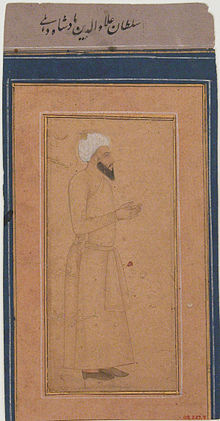Ala-ud-din Khalji
Ala-ud-din Khalji (died 1316), was the second ruler of the Khalji dynasty.[1] He was the most powerful ruler of the Khalji Dynasty. He ruled from 1296 to 1316.[2] He was the nephew (and son-in-law) of Jalal-ud-din Khalji.[2] His son was Khusrau Malik. He wished to become the second Alexander. He took the title ‘Sikander-i-Sani’.[3] He banned drinking of alcohol in open in his kingdom.[4] He was an undefeated Sultan of Hind (India), He is considered as one of the most ruthless emperors of India after he repulsed several mongol invasions In India.[5][need quotation to verify]
| Ala-ud-din Khalji | |
|---|---|
| Sultan Sikander Sani | |
 A 17th century painting of Alauddin Khalji | |
| Sultan of Delhi | |
| Reign | 19 July 1296–4 January 1316 |
| Coronation | 21 October 1296 |
| Predecessor | Jalaluddin Firuz Khalji |
| Successor | Shihabuddin Omar |
| Governor of Awadh | |
| Tenure | c. 1296–19 July 1296 |
| Governor of Kara | |
| Tenure | c. 1291–1296 |
| Predecessor | Malik Chajju |
| Successor | ʿAlāʾ ul-Mulk |
| Amir-i-Tuzuk (equivalent to Master of ceremonies) | |
| Tenure | c. 1290–1291 |
| Born | Ali Gurshasp c.1266–1267 |
| Died | 4 January 1316 Delhi, India |
| House | Khalji dynasty |
| Religion | Sunni Islam |
Military Campaigns
changeAla-ud-din Khalji first conquered Gujarat and Malwa. In 1301 he conquered Ranthambore. In 1303 he captured Chittor. Then he sent a large army headed by his general Malik Kafur to South India. Malik Kafur defeated the Yadavas, Kakatiyas, Hoysalas and the Pandyas. He sacked the cities of Madurai, Rameswaram, Tirunelveli and Kanyakumari in Tamil Nadu and captured whole south. He also took away a lot of wealth and returned to Delhi in a grand ceremony.[source?]
Economic Measures
changeKhalji needed money to keep a large army. The main sources were taxes. The land tax was fixed according to the fertility of the land. The land tax in the fertile Ganga-Yamuna doab was one-half of the produce. He kept a strict check on the nobles. A group of officers were kept to discourage corruption. He introduced a system of auditing accounts.[source?]
He introduced a market control policy in which he reduced the price of day to day items such as sugar, oil, cloth etc. Shop owners had to pay the amount fixed by Ala-ud-din Khalji. Officials were appointed to check the shop owners. Whoever was caught cheating, was punished. This allowed Khalji to pay a low salary to the soldiers.[source?]
Army Reforms
changeWith money available to him he maintained a large army. He paid his soldiers in cash.[6] He even started branding horses (Dagh).[6] This was to prevent the substitution of good horses with low quality horses. He even kept a description of all soldiers in his army (Chehra). He posted spies throughout the empire to prevent rebellions.[source?]
Related pages
changeReferences
change- ↑ "Khalji Dynasty". Encyclopædia Britannica. Retrieved 26 October 2016.
- ↑ 2.0 2.1 Radhey Shyam Chaurasia, History of Medieval India: From 1000 A.D. to 1707 A.D. (New Delhi: Atlantic Publ., 2002), p. 31
- ↑ "Interesting facts and history of Alauddin Khilji:the second Alexander". Archived from the original on 29 October 2016. Retrieved 26 October 2016.
- ↑ "History and Biography of Alauddin Khilji - Important India". 12 March 2014. Archived from the original on 13 November 2016. Retrieved 26 October 2016.
- ↑ Herbert M. J. Loewe. The Mongols.
- ↑ 6.0 6.1 Ghulam Sarwar Khan Niazi, The Life and Works of Sultan Alauddin Khalji (New Delhi: Atlantic, 1992), p. 48
Other websites
change- Interesting facts and history of Alauddin Khalji:the second Alexander Archived 2015-02-03 at the Wayback Machine
- Allauddin Khalji Biography